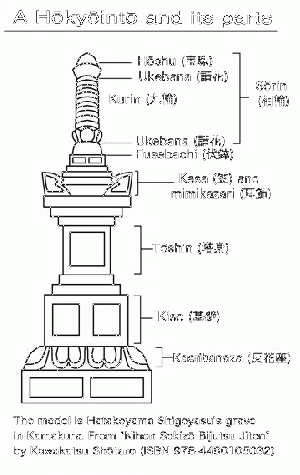Difference between revisions of "Hokyointo"
(Created page with "A ''hōkyōintō'' and its parts|thumb A hōkyōintō (宝篋印塔?) is a Japanese pagoda, so called because it originally contained the H...") |
m (Text replacement - "Category:Japanese terminology" to "{{JapaneseTerminology}}") |
||
| (5 intermediate revisions by 2 users not shown) | |||
| Line 1: | Line 1: | ||
[[Image:Houkyouintou English.gif|A ''hōkyōintō'' and its parts|thumb]] | [[Image:Houkyouintou English.gif|A ''hōkyōintō'' and its parts|thumb]] | ||
| − | A hōkyōintō (宝篋印塔?) is a Japanese pagoda, so called because it originally contained the Hōkyōin (宝篋印?) dharani (陀羅尼?) sūtra. A Chinese | + | A '''hōkyōintō''' (宝篋印塔?) is a [[Japanese]] [[pagoda]], so called because it originally contained the Hōkyōin (宝篋印?) [[dharani]] (陀羅尼?) sūtra. A Chinese variant of the Indian [[stūpa]], it was originally conceived as a cenotaph of the King of Wuyue - Qian Liu. |
Structure and function | Structure and function | ||
| − | Usually made in stone and occasionally metal or wood, hōkyōintō started to be made in their present form during the Kamakura period. Like a gorintō, they are divided in five main sections called (from the bottom up) kaeribanaza (反花座?), or "inverted flower seat", kiso (基礎?), or base, tōshin (塔身?), or body, kasa (笠?), or umbrella, and sōrin (相輪?), or pagoda finial. The tōshin is the most important part of the hōkyōintō and is carved with a Sanskrit letter. The 'sōrin has the same shape as the tip of a five-storied pagoda. The kasa can also be called yane (屋根?), or roof. It's decorated with four characteristic wings called mimikazari (耳飾?) or sumikazari (隅飾?). Different structures exist, and the hōkyōintō property of the Yatsushiro Municipal Museum in Kyushu for example is divided in just four parts, with no kaeribanaza. | + | Usually made in stone and occasionally metal or wood, [[hōkyōintō]] started to be made in their present form during the [[Kamakura]] period. Like a [[gorintō]], they are divided in five main sections called (from the bottom up) [[kaeribanaza]] (反花座?), or "inverted flower seat", kiso (基礎?), or base, [[tōshin]] (塔身?), or body, [[kasa]] (笠?), or [[umbrella]], and [[sōrin]] (相輪?), or [[pagoda]] finial. The [[tōshin]] is the most important part of the [[hōkyōintō]] and is carved with a [[Sanskrit]] letter. The '[[sōrin]] has the same shape as the tip of a five-storied [[pagoda]]. The [[kasa]] can also be called [[yane]] (屋根?), or roof. It's decorated with four characteristic wings called [[mimikazari]] (耳飾?) or [[sumikazari]] (隅飾?). Different structures exist, and the [[hōkyōintō]] property of the Yatsushiro Municipal Museum in Kyushu for example is divided in just four parts, with no [[kaeribanaza]]. |
| − | The sūtra contain all the pious deeds of a Tathagata Buddha, and the faithful believe that praying in front of a hōkyōintō their sins will be canceled, during their lives they will be protected from disasters and after death they will go to heaven. | + | The [[sūtra]] contain all the pious deeds of a [[Tathagata]] [[Buddha]], and the faithful believe that praying in front of a [[hōkyōintō]] their sins will be canceled, during their lives they will be protected from disasters and after death they will go to [[heaven]]. |
| − | The hōkyōintō tradition in Japan is old and is believed to have begun during the Asuka period (550–710 CE). They used to be made of wood and started to be made in stone only during the Kamakura period. It is also during this period that they started to be used also as tombstones and cenotaphs. | + | The [[hōkyōintō]] tradition in [[Japan]] is old and is believed to have begun during the [[Asuka]] period (550–710 CE). They used to be made of wood and started to be made in stone only during the [[Kamakura]] period. It is also during this period that they started to be used also as tombstones and cenotaphs. |
<gallery> | <gallery> | ||
| Line 18: | Line 18: | ||
{{W}} | {{W}} | ||
| − | + | {{JapaneseTerminology}} | |
[[Category:Japanese Buddhism]] | [[Category:Japanese Buddhism]] | ||
[[Category:Buddhist Terms]] | [[Category:Buddhist Terms]] | ||
| + | [[Category:Pagoda]] | ||
Latest revision as of 12:58, 27 April 2014
A hōkyōintō (宝篋印塔?) is a Japanese pagoda, so called because it originally contained the Hōkyōin (宝篋印?) dharani (陀羅尼?) sūtra. A Chinese variant of the Indian stūpa, it was originally conceived as a cenotaph of the King of Wuyue - Qian Liu. Structure and function
Usually made in stone and occasionally metal or wood, hōkyōintō started to be made in their present form during the Kamakura period. Like a gorintō, they are divided in five main sections called (from the bottom up) kaeribanaza (反花座?), or "inverted flower seat", kiso (基礎?), or base, tōshin (塔身?), or body, kasa (笠?), or umbrella, and sōrin (相輪?), or pagoda finial. The tōshin is the most important part of the hōkyōintō and is carved with a Sanskrit letter. The 'sōrin has the same shape as the tip of a five-storied pagoda. The kasa can also be called yane (屋根?), or roof. It's decorated with four characteristic wings called mimikazari (耳飾?) or sumikazari (隅飾?). Different structures exist, and the hōkyōintō property of the Yatsushiro Municipal Museum in Kyushu for example is divided in just four parts, with no kaeribanaza.
The sūtra contain all the pious deeds of a Tathagata Buddha, and the faithful believe that praying in front of a hōkyōintō their sins will be canceled, during their lives they will be protected from disasters and after death they will go to heaven.
The hōkyōintō tradition in Japan is old and is believed to have begun during the Asuka period (550–710 CE). They used to be made of wood and started to be made in stone only during the Kamakura period. It is also during this period that they started to be used also as tombstones and cenotaphs.




